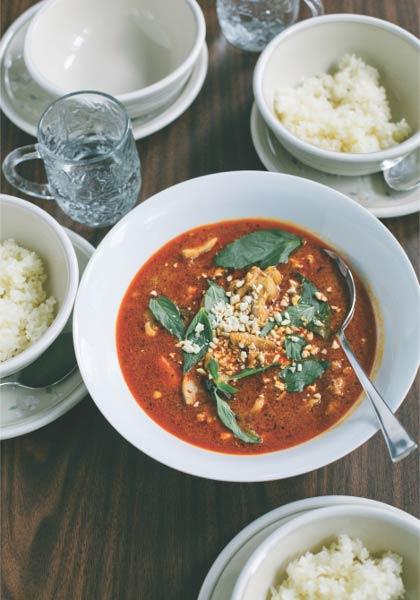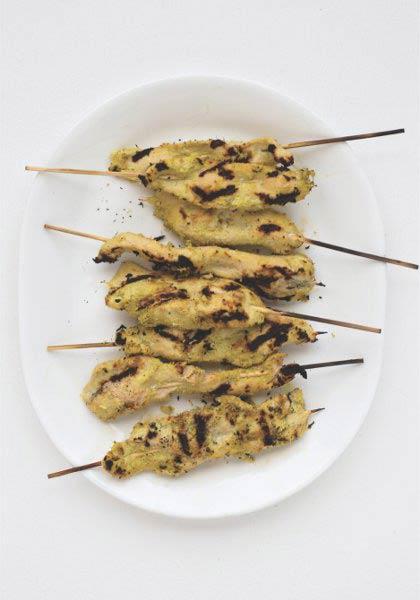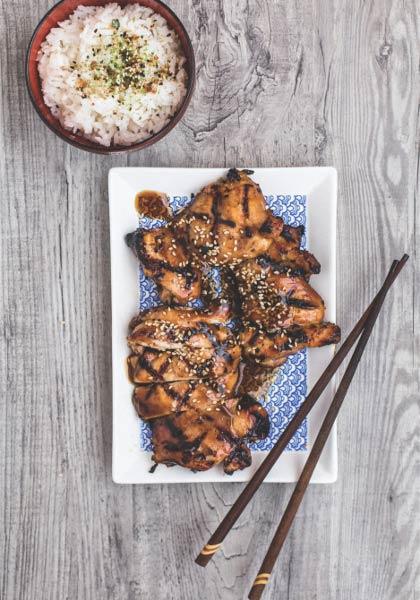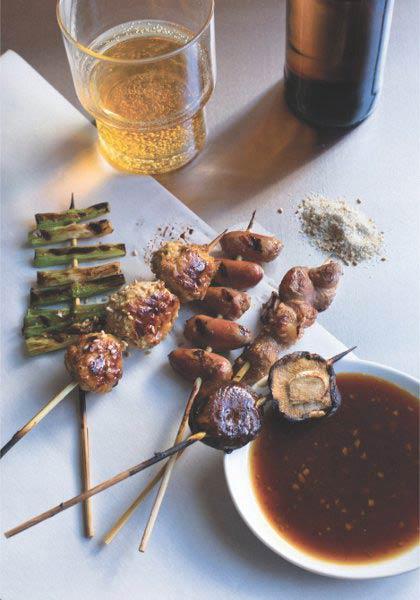The Ancestral Table: Traditional Recipes for a Paleo Lifestyle (26 page)
Read The Ancestral Table: Traditional Recipes for a Paleo Lifestyle Online
Authors: Russ Crandall

Panang is often served with pork, chicken, or shrimp in Thai restaurants in the United States, although beef is the traditional meat used in this dish. I love to make this curry with all these meats but typically use chicken for its flavor and texture.
The baseline version of this dish is not spicy; add bird’s eye chiles to get to your desired heat profile.
SERVES:
4-6
PREP TIME:
10 MINUTES, PLUS 30 MINUTES TO PREP THE PANANG PASTE
COOKING TIME:
25 MINUTES
2 TBSP. COCONUT OIL
1/4 CUP PANANG PASTE (BELOW)
1 (13.5 OZ.) CAN COCONUT MILK, DIVIDED
2-3 LBS. BONELESS, SKINLESS CHICKEN THIGHS, SLICED INTO BITE-SIZED CHUNKS
1/4 CUP CHOPPED CASHEWS
10 THAI BASIL LEAVES
2 TSP. FISH SAUCE
1 BIRD’S EYE CHILE, SEEDS AND RIBS REMOVED, SLICED INTO RINGS (OPTIONAL)
1. In a skillet, heat the coconut oil on medium heat for 1 minute, then add the Panang Paste, stirring to combine. Sauté until it becomes aromatic and the oil starts to separate from the paste, 3-5 minutes. Add a third of the coconut milk and simmer, stirring often, for another 2 minutes.
2. Add the chicken and stir in another third of the coconut milk. Bring to a simmer, then reduce the heat to medium-low. Simmer, uncovered, until the chicken is nearly cooked through, 8-10 minutes.
3. Add the chopped cashews, Thai basil leaves, fish sauce, and the remaining third of the coconut milk. Add the chile if desired. Raise the heat to medium and simmer for another few minutes until the basil leaves are soft and slightly darkened. Serve with Sticky Rice (
see here
) or Cauliflower Rice (
see here
).
PANANG PASTE
YIELDS:
1 CUP
3 LARGE DRIED MILD RED CHILES (SUCH AS GUAJILLO OR ANAHEIM)
1 TSP. CORIANDER SEEDS, TOASTED
1 TSP. CUMIN SEEDS, TOASTED
3" LEMONGRASS (WHITE BASE OF 1 STALK), COARSELY CHOPPED
2" GALANGAL, PEELED AND COARSELY CHOPPED
5 FRESH KAFFIR LIME LEAVES
1 TSP. SHRIMP PASTE (TERASI PREFERRED;
SEE HERE
)
2 GREEN CARDAMOM PODS
2 SMALL SHALLOTS
2 CLOVES GARLIC
1 TBSP. SEA SALT
1 TSP. BLACK PEPPERCORNS
1/4 CUP COARSELY CHOPPED CASHEWS
1 TBSP. WATER
1. Soak the chiles in warm water for 30 minutes, then remove the stems and seeds. Blend or process the chiles with the remaining ingredients.
2. This paste will keep in the fridge for up to 2 weeks or in the freezer for up to 6 months. Before freezing, divide the paste into 1/4 cup portions.

Chicken Satay
Originally from Indonesia, satay (often spelled sate) can be found in many Asian restaurants as an appetizer. Satay was first sold by street vendors on Java island, probably an adaptation of Indian-style kebabs, a result of Indian and Middle Eastern migration to Indonesia in the 18th and 19th centuries. From there, the dish moved to other Indonesian islands and beyond. Satay is commonly made with chicken, beef, lamb, and shrimp. More exotic variations include turtle, crocodile, lizard, snake, and rabbit.
SERVES:
6-10
PREP TIME:
10 MINUTES PLUS OVERNIGHT
COOKING TIME:
20 MINUTES
MARINADE:
2 STALKS LEMONGRASS, WHITE PARTS ONLY, CHOPPED (~1 CUP)
2 SHALLOTS
4 CLOVES GARLIC
1/2" GALANGAL, PEELED
1/2" GINGER, PEELED
2/3 CUP COCONUT MILK
2 TBSP. COCONUT OIL
2 TBSP. HONEY
2 TSP. GROUND CORIANDER
1 TSP. SEA SALT
1/2 TSP. TURMERIC
3-5 LBS. BONELESS, SKINLESS CHICKEN BREASTS, SLICED LENGTHWISE INTO 1" STRIPS
20 (8") WOODEN SKEWERS
SATAY SAUCE (
SEE HERE
)
1. Blend all the marinade ingredients, adding water if the paste is difficult to purée. Combine the paste and chicken in a resealable plastic bag and refrigerate overnight.
2. Soak the skewers in water for 1 hour. Remove the chicken from the bag and reserve the marinade. Skewer the chicken in a weaving pattern, making a weave every 1". Grill the chicken on direct medium-high heat, turning every few minutes, brushing on the reserved marinade as you turn the chicken. It should take 8 minutes total. Let rest for 5 minutes, then serve with satay sauce.

Teriyaki Chicken
Teriyaki is a popular Japanese cooking technique in which meat is basted while being grilled. As I mention in my Teriyaki Sauce recipe (
see here
), it was developed in the 17th century and is often made with fish, chicken, beef, or squid.
SERVES:
4
PREP TIME:
UP TO 4 HOURS, PLUS TIME TO PREP THE TERIYAKI SAUCE
COOKING TIME:
20 MINUTES
1 RECIPE TERIYAKI SAUCE (
SEE HERE
)
6-8 BONELESS, SKINLESS CHICKEN THIGHS
SESAME SEEDS FOR SERVING
1. Prepare the Teriyaki Sauce and let cool. Reserve 1/2 cup of the sauce. Marinate the chicken thighs in the remaining sauce for 2-4 hours.
2. Prepare your grill for indirect grilling (
see here
). Place the chicken over direct high heat, brush with the marinade, and grill until browned, about 5 minutes. Flip the chicken and brush again, grilling for another 5 minutes or until the other side is browned.
3. Move the chicken to the cool side of the grill to finish cooking; the internal temperature should reach 160°F. Brush with the reserved sauce before serving with sesame seeds sprinkled on top.

Yakitori
Yakitori (literally, “grilled chicken”) is a Japanese cooking technique that involves skewering and grilling foods. Going to a yakitori-ya (restaurant) or food stand on an empty stomach can be less than healthy for your wallet; making yakitori at home is much more affordable and is a great way to entertain guests or enjoy a dinner for two. This meal can easily be scaled up to meet your needs.
The only tricky part of this recipe is making the meatballs; ground chicken tends to be difficult to grill. I found success by partially cooking the meatballs in a pan before skewering and finishing them off on the grill. Feel free to add other foods to the skewers, such as garlic cloves, asparagus, chicken thigh strips, skin, wings, tails, and livers.
SERVES:
2
PREP TIME:
10 MINUTES, PLUS 1 HOUR TO SOAK THE SKEWERS
COOKING TIME:
20 MINUTES
CHICKEN MEATBALLS:
15 (8") WOODEN SKEWERS
1 TBSP. BUTTER
1/2 SMALL ONION, BLENDED IN A BLENDER OR FOOD PROCESSOR
1/2 LB. GROUND CHICKEN
1 SMALL FRESH SHIITAKE MUSHROOM, MINCED
1/4 TSP. LEMON ZEST
1 TSP. SEA SALT
1 TBSP. COCONUT OIL
6 CHICKEN GIZZARDS
10 CHICKEN HEARTS
4 SHIITAKE MUSHROOMS
6 GREEN ONIONS, CUT INTO 2" LENGTHS
1/2 RECIPE YAKITORI SAUCE (
SEE HERE
; SEE YAKITORI VARIATION AT END), PLUS 1/4 CUP FOR DIPPING
SESAME SEEDS TO GARNISH
1. Soak the skewers in water for 1 hour. Melt the butter in a skillet on medium heat, then add the blended onion. Sauté until softened, about 2 minutes, then transfer to a bowl to cool. Add the ground chicken, shiitake mushroom, lemon zest, and salt to the bowl, then form into 8 or 9 balls. Warm the coconut oil in a skillet on medium-high heat until shimmering, about 2 minutes, then add the meatballs and lightly brown on each side to help them keep their form. Do not cook through. Set aside to cool, then skewer with soaked wooden skewers.
2. Skewer the gizzards, hearts, shiitake mushrooms, and green onions, as well as any other foods you’d like.
3. Prepare your grill for direct cooking (
see here
). Grill the skewers over direct high heat, turning every couple minutes and basting with yakitori sauce as you turn them. Garnish with sesame seeds and serve with sesame salt powder (known as gomashio; see recipe below) and more yakitori sauce for dipping.
GOMASHIO
1 TBSP. SESAME SEEDS
1 TSP. KOSHER SALT
1. Grind the seeds and salt together with a mortar and pestle.

Roasted Duck and Potatoes
Wild ducks have been consumed since prehistory, but the Chinese claim to have domesticated ducks first, more than 3,000 years ago. Europeans weren’t far behind; the Romans maintained aviaries that included ducks. Separately, Native Americans recognized the tastiness of ducks and domesticated them before the arrival of Western Europeans.
For my recipe, I wanted to highlight the natural deliciousness of this bird with minimal fuss (although to be fair, cooking duck is easier than cooking chicken because duck’s dark meat is much less likely to dry out). In truth, the real stars of this recipe are the potatoes, which are roasted in the duck’s rendered fat; they may be the tastiest potatoes you’ve ever eaten. Other root vegetables, including carrots, parsnips, and turnips, can be mixed with the potatoes to delicious effect. Finishing the fatty bird with lemon juice adds another taste dimension.
SERVES:
4
PREP TIME:
40 MINUTES
COOKING TIME:
3 HOURS
1 WHOLE DUCK (3-5 LBS.)
1 TSP. KOSHER SALT
1 TSP. BLACK PEPPER
1/2 ONION, QUARTERED
5 SPRIGS THYME
5 FRESH SAGE LEAVES
2 LBS. RUSSET POTATOES (4-5), PEELED AND QUARTERED
JUICE OF 1/2 LEMON (1 TBSP.)
1. Pat the duck dry inside and out with paper towels. Trim any extra skin and fat from both openings and reserve for rendering (see pages 40-41). If there is a neck attached, cut it at the base of the shoulder and reserve for making broth (
see here
). Set the duck on a roasting rack or wire rack to air-dry for 30 minutes. As the duck dries, preheat the oven to 350°F.
2. Pierce the duck skin (not the meat) all over with a fork, then cover with the salt and pepper. Stuff the onion quarters and herbs into the cavity. Suspend the duck over a baking sheet on the roasting rack—the higher the better—then place in the oven to roast for 1 hour. I like to dust the giblets (heart, liver, and gizzards) with tapioca starch and pan-fry them in butter to eat while the duck is roasting.